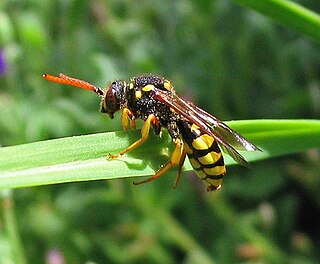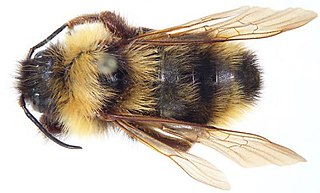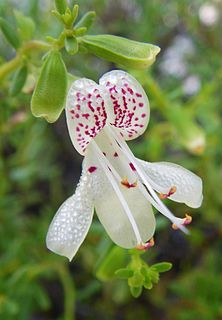
Yellowjacket or yellow jacket is the common name in North America for predatory social wasps of the genera Vespula and Dolichovespula. Members of these genera are known simply as "wasps" in other English-speaking countries. Most of these are black and yellow like the eastern yellowjacket Vespula maculifrons and the aerial yellowjacket Dolichovespula arenaria; some are black and white like the bald-faced hornet, Dolichovespula maculata. Others may have the abdomen background color red instead of black. They can be identified by their distinctive markings, their occurrence only in colonies, and a characteristic, rapid, side-to-side flight pattern prior to landing. All females are capable of stinging. Yellowjackets are important predators of pest insects.

Mason bee is a name now commonly used for species of bees in the genus Osmia, of the family Megachilidae. Mason bees are named for their habit of using mud or other "masonry" products in constructing their nests, which are made in naturally occurring gaps such as between cracks in stones or other small dark cavities. When available, some species preferentially use hollow stems or holes in wood made by wood-boring insects.

Hylaeus is a large and diverse cosmopolitan genus within the bee family Colletidae.

With over 850 species, the genus Nomada is one of the largest genera in the family Apidae, and the largest genus of kleptoparasitic "cuckoo bees." Kleptoparasitic bees are so named because they enter the nests of a host and lay eggs there, stealing resources that the host has already collected. The name "Nomada" is derived from the Greek word nomas (νομάς), meaning "roaming" or "wandering."

Hylaeus alcyoneus, commonly known as the banksia bee, is a bee species endemic to Australia where it is commonly found in the coastal heaths of eastern and southern Western Australia. This bee is an important pollinator of Banksia species.

Bombus suckleyi is a species of bumblebee known commonly as Suckley's cuckoo bumblebee, named after biologist George Suckley. Suckley's bumble bee is a generalist pollinator and represents a rare group of obligate, parasitic bumble bees. Suckley's bumble bee is a social-parasite because it invades the nests of the host bumble bees, including the western bumble bee, and relies on host species workers to provision its larvae. It is native to northwestern North America, including Alaska and parts of western and central Canada and the western United States.

Bombus occidentalis, the western bumblebee, is one of around 30 bumblebee species present in the western United States and western Canada. A recent review of all of its close relatives worldwide appears to have confirmed its status as a separate species.

Dicerandra christmanii is a rare species of flowering plant in the mint family known by the common names Garrett's mint, yellow scrub balm, and Lake Wales balm. It is endemic to Highlands County, Florida, in the United States, where it is known from only four sites on the Lake Wales Ridge. All are contained within a tract of land measuring 6 kilometers by 3 kilometers. The plant is steadily declining due to the destruction and degradation of its habitat, and only one of the four occurrences is on protected land. It is a federally listed endangered species.

Andrena agilissima is a species of mining bee. They are present in most of Europe, the Near East and North Africa and can be found from April through July. Andrena agilissima is an oligolectic species, feeding only on the pollen of a few genera of Cruciferous vegetables.

Bombus fervidus, the golden northern bumble bee or yellow bumblebee, is a species of bumblebee native to North America. It has a yellow-colored abdomen and thorax. Its range includes the North American continent, excluding much of the southern United States, Alaska, and the northern parts of Canada. It is common in cities and farmland, with populations concentrated in the Northeastern part of the United States. It is similar in color and range to the American bumblebee. It has complex behavioral traits, which includes a coordinated nest defense to ward off predators. B. fervidus is an important pollinator, so recent population decline is a particular concern.

Bombus affinis, commonly known as the rusty patched bumble bee, is a species of bumblebee endemic to North America. Its historical range in North America has been throughout the east and upper Midwest of the United States, north to Ontario, Canada, where it is considered a "species at risk", east to Quebec, south to Georgia, and west to the Dakotas. Its numbers have declined in 87% of its historical habitat range. On January 10, 2017, the United States Fish and Wildlife Service placed B. affinis on the list of endangered species, making the rusty patched bumblebee the first bee to be added to the list in the continental United States.

Osmia uncinata, the pinewood mason bee, is a species of solitary bee from the family Megachilidae It is an Arctic-alpine species which is found in the northern Palearctic, in the United Kingdom it is a Biodiversity Action Plan priority species.
Hylaeus anthracinus is a species of bee, also known by the common name anthricinan yellow-faced bee. It is endemic to Hawaii and known from only 16 populations. In September 2016, along with six other Hawaiian Hylaeus species, H. anthracinus was listed for protection under the United States Endangered Species Act. This marked a first listing for any bee species in the US.
Hylaeus assimulans is a species of bee, also known by the common name Assimulans yellow-faced bee. It is endemic to Hawaii and known from only five populations. In September 2016, along with six other Hawaiian Hylaeus species, H. assimulans was listed for protection under the United States Endangered Species Act. This marked a first listing for any bee species in the US.
Hylaeus facilis is a species of bee, also known by the common name easy yellow-faced bee. It is endemic to Hawaii and known from only two populations. In September 2016, along with six other Hawaiian Hylaeus species, H. facilis was listed for protection under the United States Endangered Species Act. This marked a first listing for any bee species in the US.
Hylaeus hilaris is a species of bee, also known by the common name hilaris yellow-faced bee. It is endemic to Hawaii and known only from a single population. In September 2016, along with six other Hawaiian Hylaeus species, H. hilaris was listed for protection under the United States Endangered Species Act. This marked a first listing for any bee species in the US.
Hylaeus kuakea is a species of bee, also known by the common name Hawaiian yellow-faced bee. It is endemic to Hawaii and known from only two populations. In September 2016, H. kuakea and six other Hawaiian Hylaeus species were listed for protection under the United States Endangered Species Act. This marked a first listing for any bee species in the US.
Hylaeus mana is a species of bee, also known by the common name Hawaiian yellow-faced bee. It is endemic to Hawaii and known from only four populations. In September 2016, along with six other Hawaiian Hylaeus species, H. mana was listed for protection under the United States Endangered Species Act. This marked a first listing for any bee species in the US.

Hylaeus agilis, commonly known as the Agile masked bee, is a bee species in the family Colletidae. It is endemic to New Zealand. This species is found throughout the country and visits the flowers of a wide variety of plant species, both native and introduced.

Hylaeus relegatus, also known as the Māori masked bee, is a bee species in the family Colletidae. It is endemic to New Zealand and was first described by Frederick Smith. It is the largest and most common species of this genus in that country. H. relegatus can be found throughout the three main islands of New Zealand and visits the flowers of a wide variety of plant species, both native and introduced. Although widespread, this species is not abundant at any one particular location. It has been hypothesised that human made nest sites can be used to increase its numbers.














